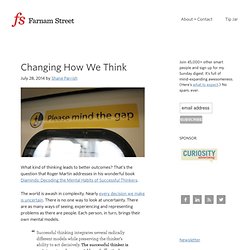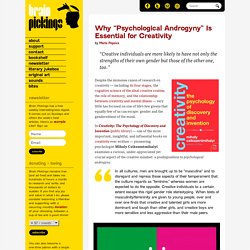

Resolving the Paradox of Group Creativity. Researchers have been studying creativity for more than 150 years, yet it still remains elusive.

We’re not much closer to understanding what it is exactly that sparks unique ideas. One reason for this lack of insight may be that so much research has looked at the wrong things. Until quite recently, creativity has been studied from the assumption that it is a function of particular individuals and their characteristics. Researchers have asked, “What is it about certain people that causes unique ideas to emerge from their minds?” Functional fixedness. Functional fixedness is a cognitive bias that limits a person to using an object only in the way it is traditionally used.

The concept of functional fixedness originated in Gestalt Psychology, a movement in psychology that emphasizes holistic processing. Karl Duncker defined functional fixedness as being a "mental block against using an object in a new way that is required to solve a problem. "[1] This "block" limits the ability of an individual to use components given to them to complete a task, as they cannot move past the original purpose of those components.
For example, if someone needs a paperweight, but they only have a hammer, they may not see how the hammer can be used as a paperweight. When tested, 5-year-old children show no signs of functional fixedness. Examples in research[edit] Experimental paradigms typically involve solving problems in novel situations in which the subject has the use of a familiar object in an unfamiliar context. Candle box[edit] Two-cord problem[edit] Gever Tulley: Life lessons through tinkering. TEDxParis 2012 - Cedric Villani - La naissance des idées. Threshold Theory: How Smart Do You Have to Be to Succeed? The Argumentative Theory. "Reasoning was not designed to pursue the truth.

Reasoning was designed by evolution to help us win arguments. That's why they call it The Argumentative Theory of Reasoning. So, as they put it, "The evidence reviewed here shows not only that reasoning falls quite short of reliably delivering rational beliefs and rational decisions. It may even be, in a variety of cases, detrimental to rationality. Reasoning can lead to poor outcomes, not because humans are bad at it, but because they systematically strive for arguments that justify their beliefs or their actions. "Now, the authors point out that we can and do re-use our reasoning abilities. Dan Sperber, an influential French social and cognitive scientist, is widely recognized as being among the most brilliant cognitive scientists writing about reason, language, culture, and human evolution.
Their Argumentative Theory has already generated much excitement in the academic community. Changing How We Think. What kind of thinking leads to better outcomes?

That’s the question that Roger Martin addresses in his wonderful book Diaminds: Decoding the Mental Habits of Successful Thinkers. The world is awash in complexity. Nearly every decision we make is uncertain. There is no one way to look at uncertainty. There are as many ways of seeing, experiencing and representing problems as there are people. Successful thinking integrates several radically different models while preserving the thinker’s ability to act decisively. Integrators attempt to hold two, often contradictory, ways of seeing the world. This is reminiscent of F. The test of a first-rate intelligence is the ability to hold two opposing ideas in mind at the same time and still retain the ability to function.
Le cerveau à tous les niveaux. How Our Brains Work When We Are Creative: The Science of Great Ideas. 466 Flares Filament.io 466 Flares × Ah, ideas. Who doesn’t want more great ideas? I know I do. I usually think about ideas as being magical and hard to produce. I expect them to just show up without me cultivating them, and I often get frustrated when they don’t show up when I need them. The good news is that it turns out cultivating ideas is a process, and one that we can practice to produce more (and hopefully better) ideas. First, let’s look at the science of the creative process. How our brains work creatively So far, science hasn’t really determined exactly what happens in our brains during the creative process, since it really combines a whole bunch of different brain processes. The truth is, our brain hemispheres are inextricably connected. The idea that people can be “right brain thinkers” or “left brain thinkers” is actually a myth that I’ve debunked before:
Why We're More Creative When We're Tired and 9 Other Surprising Facts About How Our Brains Work. 12.6K Flares Filament.io 12.6K Flares × One of the things that surprises me time and time again is how we think our brains work and how they actually do.

On many occasions I find myself convinced that there is a certain way to do things, only to find out that actually that’s the complete wrong way to think about it. For example, I always found it fairly understandable that we can multitask. Well, according to the latest research studies, it’s literally impossible for our brains to handle 2 tasks at the same time. Charles Limb: Your brain on improv. Amy Tan: Where does creativity hide? Language & Prospective Mind. Why “Psychological Androgyny” Is Essential for Creativity. By Maria Popova “Creative individuals are more likely to have not only the strengths of their own gender but those of the other one, too.”

Despite the immense canon of research on creativity — including its four stages, the cognitive science of the ideal creative routine, the role of memory, and the relationship between creativity and mental illness — very little has focused on one of life’s few givens that equally few of us can escape: gender and the genderedness of the mind. In Creativity: The Psychology of Discovery and Invention (public library) — one of the most important, insightful, and influential books on creativity ever written — pioneering psychologist Mihaly Csikszentmihalyi examines a curious, under-appreciated yet crucial aspect of the creative mindset: a predisposition to psychological androgyny. Illustration by Yang Liu from 'Man Meets Woman,' a pictogram critique of gender stereotypes. Click image for details.